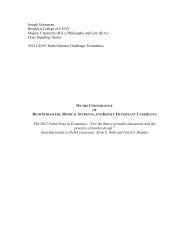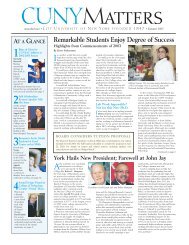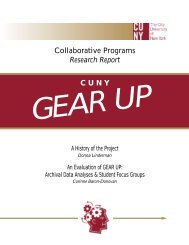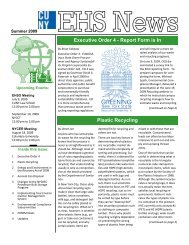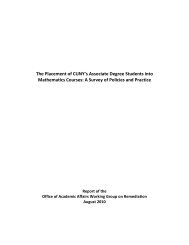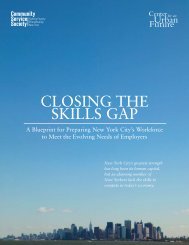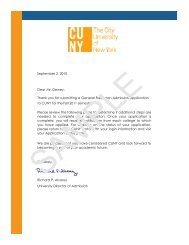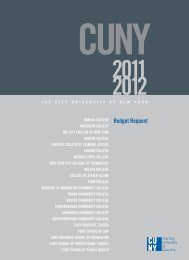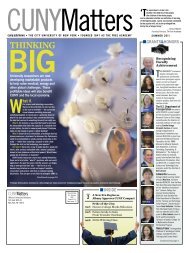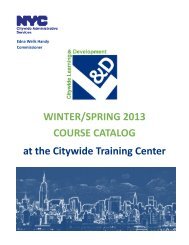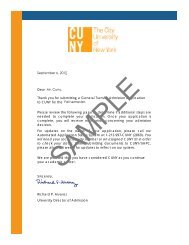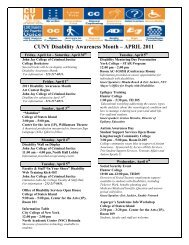CUNY Master Plan 2012-2016
CUNY Master Plan 2012-2016
CUNY Master Plan 2012-2016
You also want an ePaper? Increase the reach of your titles
YUMPU automatically turns print PDFs into web optimized ePapers that Google loves.
THE <strong>CUNY</strong> MASTER PLAN <strong>2012</strong>-<strong>2016</strong><br />
These and other workforce changes will impact the education of health care professionals across the<br />
University. A major priority from <strong>2012</strong>-<strong>2016</strong> will be to align the health professions programs with federal<br />
and state health care legislation and with recommended reforms. Nursing provides a good example of<br />
what is being done and what must be done.<br />
Nursing<br />
Registered Nurses (RNs) are the single largest occupation in the health sector, constituting 18 percent<br />
of all jobs in the industry. However, spending cuts resulting from the economic downturn plus recent<br />
hospital closings, mergers, downsizings, and hiring freezes have made the local job market more competitive<br />
for new nurse graduates. It is difficult to anticipate precisely how these patterns may shift by <strong>2016</strong>.<br />
However, because of the current circumstances and the new emphasis on community-based services, the<br />
University has become more active in implementing “transition-to-practice” programs that facilitate the<br />
re-deployment of new AAS nurses to expanding health sectors in community-based settings.<br />
Recent national reports and changes in personnel practices reflect a strong preference for a more<br />
highly educated nursing workforce. There is a broad consensus among nursing faculty, nursing professionals,<br />
and many employers that the BS in nursing is preferred over the AAS degree. In 2009, the<br />
Carnegie Foundation recommended the baccalaureate degree as the appropriate credential for RNs<br />
entering the profession. The 2011 Institute of Medicine (IOM) report recommended an increase in the<br />
proportion of nurses with a baccalaureate degree to 80 percent by 2020. <strong>CUNY</strong> currently has nine AAS<br />
degree programs and six baccalaureate programs. To align <strong>CUNY</strong>’s nursing programs with current<br />
trends, the University is working to increase its capacity at the baccalaureate level. <strong>CUNY</strong> is already<br />
experiencing a dramatic surge in enrollment in RN to BS programs. The annual number of graduates<br />
from these completion programs has increased 145 percent in the last four years. For the reasons cited<br />
above, this trend is likely to continue during <strong>2012</strong>-<strong>2016</strong>, and <strong>CUNY</strong> will continue to encourage students<br />
to pursue more advanced (baccalaureate) study.<br />
There are several models for providing a seamless transition from the AAS to the BS in nursing within<br />
an integrated university such as <strong>CUNY</strong>. One is the dual-enrollment/dual-degree program that was<br />
approved last year between Queensborough Community College and Hunter College, and which enrolled<br />
its first cohort this year. Hostos, Bronx, and LaGuardia Community Colleges are partnering with Lehman<br />
College to develop similar programs. New York City College of Technology, Staten Island, and Kingsborough<br />
are collaborating on another model, a “1-2-1” dual degree option in which nursing students earn<br />
their AAS in three years and their BS degree at the end of the fourth year. These models that directly link<br />
AAS and BS degrees in nursing will continue to be developed through <strong>2016</strong> and beyond. By <strong>2016</strong> there<br />
will be about 400 nursing students enrolled in these types of collaborative, career-ladder programs.<br />
Another IOM recommendation is to double the number of nurses with a doctorate by 2020. <strong>CUNY</strong>’s<br />
Doctor of Nursing Science (DNS) program, which is a research-oriented degree, is a critical component in<br />
the effort to increase <strong>CUNY</strong>’s capacity at the BS level by growing <strong>CUNY</strong>’s own nurse educators. The DNS<br />
program has essentially reached its capacity (about 55 students enrolled each year) and will maintain<br />
that enrollment. Recently <strong>CUNY</strong> received approval for a new Doctor of Nursing Practice (DNP) program<br />
78



